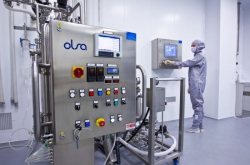The free blowing technique
Just imagine that the steel rod is an apple, and the furnace is a keg of boiling caramel. To create your glass item, you'll have to use the rod, called the glassblower's pipe, to take melted glass from the furnace at 1380 degrees minimum, while rotating it like they do with an apple in caramel. After the glass is inside the pipe, you can start blowing. If you want to make several copies of one item, you can use the hand blowing technique and a set of molds; yet, if it’s some unique piece you aspire to make, you'll have to do the "free blowing". "Free blowing" is a technique when the master blows glass through a pipe into a molten sphere, helping himself with tongs. Then, the raw piece is taken of the pipe and placed on an iron rod. Now, one can do anything he wants with the glass sphere — bend it, shape it, or even cut it with special instruments.
Three in one
A workshop at the Saint Petersburg Art and Industry Academy uses this method to make unique glass items in a furnace of their own design. Its first prototype was created by Master Ivan Kozitsin from the Academy's Department of Ceramics and Glass. As opposed to gigantic furnaces of large plants that ceaselessly work for years and melt hundreds of kilograms of glass, his invention worked with much lesser amounts. Thus, the Academy's staff got an idea: what if they make an even smaller furnace which will reduce the costs and allow those who don't do batch production create their single items? And that was the beginning of the GUTTE startup.

"Glassblowing in our country developed as following: in the time of the Soviet Union, glassblowing industry used gigantic plants. The Leningrad Art Glass Plant had enormous furnaces and flow production with whole teams of artists and glassblowers. The furnaces worked non-stop, as when you stop the production, the furnace "dies". Yet, this process was really resource-intensive, as to manufacture the product one had to melt an enormous amount of glass, which consumes lots of power", shares Tamara Kovaleva, the project's head.
In the 90-s, when the great plants began to close, there was no one to take over the glassblowing business. No entrepreneur is ready to start with large batches, and the old equipment was not meant to work with small ones. This was when Ivan Kozitsin started to think up a new technology that would let one work with smaller amounts of materials. In 2015, he got the patent on a furnace that worked with 30 kilograms of glass. A year later, the Academy's team decided to further develop the invention by making it even smaller and combining three furnaces in one.
"We've conducted marketing research and learned that no one produces such equipment in Russia;as for foreign counterparts, mostly American, German and Swedish, they are 3−5 times more expensive. Also, those are not very cost efficient, as one has to buy a set of three furnaces: one for melting the glass, one for shaping it and the one where the glass cools at 500 degree Celcium. We proposed a solution that combines three of them in a single furnace. What is more, out furnace isn't big, so it can be fitted almost anywhere, and can melt eight kilograms of glass as efficiently as its industrial counterparts that melt tens of kilograms at once. We've already used it and checked its efficiency", explains Ms. Kovaleva.

At the same time, the project's team started to work with ITMO University and became a resident of the Future Technologies accelerator. In only a year, they've succeeded in completing the furnace's industrial design, making it smaller and more functional. At the Future Technologies accelerator, the startup also got its current name, and elaborated its development strategy.
"First of all, we will work on decreasing the production cost of the furnace, and its weight. We already have a working prototype, so now we just have to further improve its properties. Surely, we plan on expanding the product range- in future, we plan to produce furnaces for both our own and consumer needs. We might also try other options, like leasing equipment, as well", shares the project's head.
The next step
Though the new invention made glassblowing a lot more affordable for entrepreneurs who can now try producing a small batch and entering the market, one part of glass industry — production of glass itself — remains a business few can handle. Still, GUTTE's team is aiming for this niche, as well.

"Apart from new types of furnaces, we also have to develop and launch the production of raw material — glass. That will let us supply glass production on all stages. As of now, all raw glass comes from the United States, and after 2014 it has become a lot more expensive. That is why working in this field is most promising. Any time soon, we plan on building a laboratory furnace, where we will work on glass melting. Surely, the composition of our glass will be a trade secret, as it is always unique", comments Tamara Kovaleva.
GUTTE's team plans to get the first samples of their glass as soon as in three months. They've already presented their prototype at the DemoDay of the Future Technologies accelerator that was held at ITMO University on April, 18th. During their presentation,on could see how glass items are produced, and even try making one.





